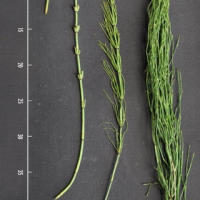Marsh horsetail
Equisetum palustre
Introduction:
Equisetum palustre, commonly known as marsh horsetail, is a perennial herbaceous plant belonging to the Equisetaceae family. It is part of the Equisetum genus, which includes plants commonly known as horsetails or scouring rushes. Marsh horsetail is often found in wetland habitats, including marshes, swamps, and the edges of ponds and streams.
Identification:
Appearance: Marsh horsetail typically grows in clumps, with stems that are hollow, jointed, and have distinct whorls of small, scale-like leaves. The stems can reach heights of 20 to 60 cm. The fertile stems produce cone-like structures at their tips.
Distinctive Features:
- Growth Form: Perennial herbaceous plant, growing in clumps with hollow, jointed stems.
- Leaves: Scale-like leaves arranged in whorls along the stems.
- Fertile Stems: Cone-like structures produced at the tips of fertile stems.
Habitat and Distribution:
Marsh horsetail is adapted to wet and marshy habitats, making it a common sight in wetlands, swamps, and along the shores of bodies of water. It is distributed in various regions globally, including parts of Europe, Asia, and North America.
Ecological Role:
-
Wetland Stabilization: Marsh horsetail, along with other wetland plants, plays a role in stabilizing wetland ecosystems.
-
Habitat for Wildlife: The dense growth of horsetails provides habitat and cover for various wetland-dwelling organisms.
Cultural Uses:
Historically, various species of horsetails have been used for medicinal purposes and for their high silica content, which made them suitable for polishing and scouring. However, caution should be exercised as some horsetails contain substances that can be toxic if consumed in large quantities.
Management Strategies:
-
Conservation: In natural wetland settings, conservation efforts may focus on preserving the integrity of these ecosystems and protecting native flora.
-
Invasive Concerns: Marsh horsetail is not typically considered invasive, but it's essential to monitor wetland areas for potential threats to native biodiversity.
Caution: While marsh horsetail is generally harmless, it's important to note that some species within the Equisetum genus contain toxic substances, and caution should be exercised when considering any traditional or herbal uses.









